|
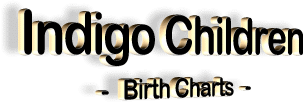
by M. English
2004
from ChildrenOfTheNewEarth Website
AS A HOMEOPATH AND ASTROLOGER I see a
lot of Indigo Children that are brought to me, not because they are
Indigo, but because of physical or behavioral problems.
Since most
of the parents I meet have not heard of Indigo Children I will
describe the generally accepted principles for identifying Indigos,
as well as how to recognize and identify them from their Birth
charts.
The first Indigo that I met in my practice, was a nine-year-old boy
who came to see me in 2002. His Mum brought him along, partly
because she was having difficulty with the various labels her child
had been given, but also because he was suffering from
sleeplessness, was argumentative, aggressive and ‘angry with the
world’. On further questioning it transpired that a younger brother
had been born blind with part of his brain missing. He also had
terrible acid reflux and was awake for 20 hours in every 24.
Sadly,
this little boy didn’t live long and eventually died. My patient,
though, had shown a natural affinity for his suffering and used to
touch his head before communicating with his brother, even though
no-one had told him to do this. His mother said her nine-year old
had had an ‘understanding’ of his brother’s needs.
Without revealing too many details of this boy’s case, I prescribed
a remedy and arranged to see him again in a month’s time. I met the
boy’s mother a while later at the school and she told me how, a few
days after taking the remedy, he had been at his grandmother’s and
had fallen asleep on the sofa. Because he was so quiet and seemed so
‘dead to the world’, Nan had got worried that he’d actually died...
Apparently, he had never done anything like this before, but I knew
this meant the remedy was starting to heal him.
As this boy had been brought to me for Homeopathic treatment, I
didn’t automatically draw up his Birth-chart, but after his second
follow-up appointment something made me ask his birth-time and I
looked at his chart. During this particular month, I visited a
Healing Fair in Bath where I live and was drawn to buy a book called
The Indigo Children by Lee Carroll and
Jan Tober. The book came home
with me, and stayed there. I now don’t lend it out, I advise people
to buy their own copy!
The book described so accurately this particular boy and his
problems, that I then bought
The Care and Feeding of Indigo Children
by Doreen Virtue, so I could offer his Mum some hope and explain
that this boy isn’t a challenge, the system looking after him is...
Then I compared his chart to others in my collection and noticed a
striking similarity with certain children’s charts I had treated
recently and some I had treated quite a few years before. Then
another boy from the first boy’s class was brought to me and his
chart had the same configuration, as did my son’s, who is also in
the same class.
In fact, over ten children in this grade all had
similar charts. This set me on a mission that still intrigues me to
this day.
Now things were beginning to make some sense, and, not being an
Indigo myself, I found it exciting to be able to offer some hope to
ADD and ADHD children, as well as those with the characteristics
that Doreen Virtue had identified as being:
-
Strong-willed
-
Born in 1978 or later
-
Headstrong
-
Creative, with an artistic flair
for music, jewellery making, poetry etc.
-
Prone to addictions
-
An ‘old soul’, as if they’re 13
going on 43
-
Intuitive or psychic, possibly
with a history of seeing angels or deceased people
-
An isolationist, either through
aggressive acting-out, or through fragile introversion
-
Independent and proud, even if
they’re constantly asking for money
-
Possesses a deep desire to help
the world in a big way
-
Wavers between low self-esteem
and grandiosity
-
Bores easily
-
Has probably been diagnosed as
having ADD or ADHD
-
Prone to insomnia, restless
sleep, nightmares, or difficulty/fear of falling asleep
-
Has a history of depression, or
even suicidal thoughts or attempts
-
Looks for real, deep and lasting
friendships
-
Easily bonds with plants or
animals
I then contacted Sarah Wood, the
President of
The Indigo Network to see if this was just a local
phenomena or whether it was worldwide?
Sarah advised me to post my
questions on her website so that people could reply to me. They have
been sending me their Birth-data for over a year now and I was not
surprised to see that every person who knew they were an Indigo, had
this same planetary shape to their chart.
So what planetary patterns were happening while these Indigos were
being born?
I took my computer on a lengthy journey from 1977-1998 and
discovered the following.
In September 1977 the major planets had moved into the following
signs:
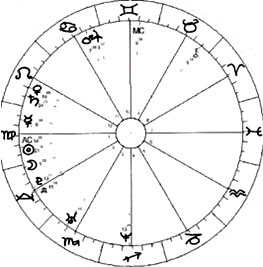
First indigo date
As you will notice, all the signs follow
each other. This was when the first Indigos began to be born.
These
are the early Indigos and the heavy planets are close, but in
separate signs. By 1981 the first conjunction occurs, with Saturn,
Pluto and Jupiter in Libra. By 1983 Jupiter has caught up with
Uranus in Sagittarius. In 1989 Uranus, Saturn and Neptune are all in
the signs of Capricorn.
Now - what if you were born at this time and all your personal
planets were in these same signs? What would make you different (or
the same) as others?
First of all, you would be very focused in certain areas. You’d know
how to operate the Play-station, but you might have problems tying
your shoelaces or remembering to wipe your feet... Your chart shape
would be called a ‘Bundle’, or a ‘Bowl’, and you would have
interests that would definitely need to be expressed otherwise
problems would occur.
In my practice I have noticed that Indigo Children have birth charts
that are rather unique. All their planets are located on one side of
the chart, i.e. six houses or less (out of twelve) are occupied and
six (or more) are empty, meaning that their energies are strong in
certain areas, and non-existent in others.
In ‘The Bowl’ shape, all the planets are concentrated within one
half of the chart. Reflecting the shape of this pattern, ‘Bowl’
types are said to be immensely self-contained and resourceful, but
they also tend to be ‘one-sided’, so their life’s challenge is to
integrate the empty half of the chart.
The ‘Bundle’ shape is rare, and reflects a narrowness of vision and
experience. ‘Bundle’ types tend to channel their energies into
issues related to the occupied section at the expense of the rest of
their chart. This shape describes the specialist in his or her
field, or, negatively, the obsessive personality. And because a
‘Bundle’ chart has no oppositions, the person whose chart it is,
will have more difficulty seeing things from others’ perspectives,
unless those ‘other’s’ are fellow Indigos.
A ‘Bundle’, or ‘Cluster’,’ is not an especially rare shape; 30% of
my clients have this configuration. What is rare, however, is having
Neptune and Uranus conjunct (in the same sign). This only ever
happens in the sign of Capricorn and last happened in 1827 (before
that in 1657) and will next occur in 2157.
From 1978-1989 the bundle of planets stayed together, various outer
planets moved a little and at certain times of each year, personal
planets clustered with the biggies.
-
So, what does a cluster feel like?
-
What does it look like from the
outside?
-
And what do cluster charts have that Splays or Grand Trines
do not?
From my observations, clusters have an intensity as well as a
complete and natural understanding of their peer group and their
generation.
We all know what it feels like to be out on a limb and
not recognized by others. The child born at the wrong time, in the
wrong place, and the wrong era really. Well, Indigos don’t suffer
that. They were born in exactly the right year/month/day location.
We all choose our parents in the planning stage before we were born
(see Judy Hall’s
Hands Across Time), and maybe Indigos are a little
more astute at doing this.
Indigos understand fashion, latest gadgets, popular music, popular
TV soaps/programs. They know what is ‘cool’ and what is not. Why?
Because their outer planets are all together with their personal
planets. They’re not usually interested in history or old out-dated
ideas. (God forbid that they should like folk music!)
Now let’s look at some charts of Indigos that I have treated.
To accurately display the full
implications of an Indigo Chart, you need to use
Equal-House System.
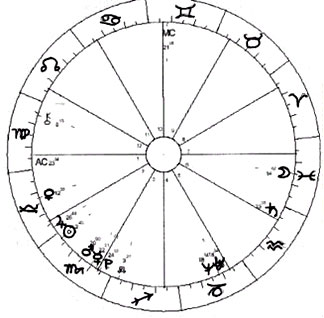
Male
Born Oct 26, 1993
3.15am
Bath, UK.
Here we have the typical one-sided chart. All the planets are
below the horizon, indicating someone who understands themselves
well, but isn’t so good at socializing and mixing with others.
Take Chiron out of the picture for the minute, because for this
analysis I won’t be using him to determine if the child is
Indigo. (however it’s useful to keep Chiron in mind as the point
of healing) All the planets are in five houses. Neptune and
Uranus are conjunct in Capricorn, and there are no oppositions.
Because all the planets in an Indigo Chart are so near together,
you have to look to see which planet is nearest the Sun, as this
will be the one that has the most influence. In this chart,
Jupiter is on one side of the Sun and Mars is on the other,
making a child who is expansive on one hand, and a little
fearless/aggressive on the other... but he has Moon in Pisces,
which makes him emotional, empathetic and sensitive. Plus, he’s
a Scorpio, so don’t try telling him what to do. What a
combination!
This child also has two planets in the 4th house,
making him unsettled at home and dreamy. Because Mars is so near
the Sun this child would do best at physical, active, sporty
pursuits, rather than at totally desk-bound activities. And,
with Venus on the Ascendant, he has charm!
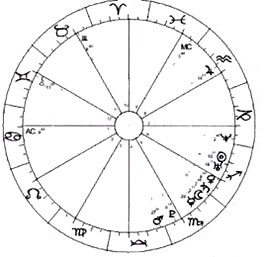
Female
10th December 1985
5.30pm
Dublin, Ireland
Next we have the chart of a young lady who contacted me via the
Indigo website. As you can see she, too, is very clustered with
all her planets squashed into three houses with only Jupiter on
his own.
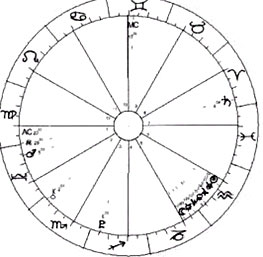
Female
5th Feb 1997
8.02 pm
London
This child was brought to me with eczema and her mother had a
whole host of problems when we started treatment. As you can see
, she has seven planets in the 5th house, Mars on the Ascendant,
Saturn in the 7th and Pluto in the 3rd. This young lady needed
to be guided, not instructed. In fact, even when she was in
nursery school, she was telling the other kids what to do!
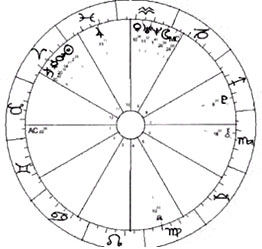
Male
23rd March 1998
7.39am
Kent
This young lad was born on 23rd March, 1998 in Maidstone Kent at
7:39am. His mother told me:
“Recently I went to see a
spiritualist as I was fed up with school accusing him of having
ADHD and suggesting Ritalin use. The lady said G was an Indigo
child, looked after by my father his own angel who died 2 years
ago.”
This boy has all his planets above the horizon, with
Uranus conjunct Neptune and, again, Mars and Jupiter positioned
either side of his Sun.
So, if you possess the twelve characteristics that Doreen Virtue
lists and a Bundle or Cluster chart, then in my humble opinion,
you are an Indigo.
Now, what makes living with/teaching/parenting an Indigo
difficult is their concentration of energies in one place. So my
advice is, provide them with an outlet for them. Look at Flower
Essences or Homeopathy.
Let them take exercise, eat well, play,
mix with friends, write poetry, play music, create. To get the
best from a child with a cluster chart shape, allow them
autonomy. They’re wiser than you anyway, so you might as well
let them make some decisions themselves. Allow them to choose
certain actions in their lives and to be guided by their own
feelings. After all, none of these children that were brought to
me ever suffered from a lack of self-esteem. On the contrary,
it’s generally been the other way around, with them being almost
too confident and too self-assured.
Key to the symbols used in the charts:
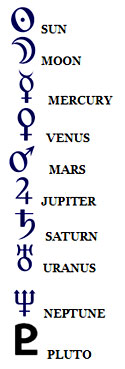
|






